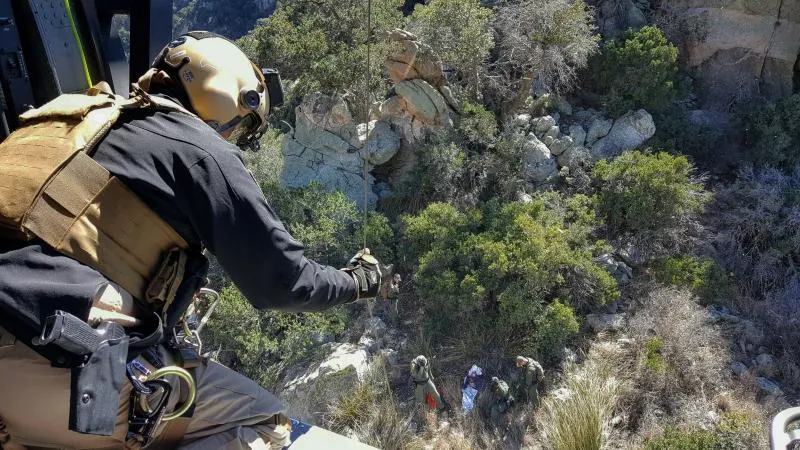Author: Acting Commissioner Kevin K. McAleenan
When people talk about U.S. Customs and Border Protection, they are usually talking about our visible frontline mission: our CBP officers who conduct inspections of people and cargo at our ports of entry and international mail facilities; our Border Patrol agents who secure our borders between ports of entry; our Air and Marine officers and agents who patrol our coastal skies and waterways; our trade specialists working to safeguard the economy with partners in the supply chain. What too often gets overlooked is the humanitarian aid we provide to people who find themselves in need of rescue or medical assistance. Nowhere is this work more challenging than between ports of entry on our Southwest Border where Border Patrol and Air and Marine Interdiction agents operate.

members from the Tucson Air Branch
worked to locate, stabilize and rescue
a Guatemalan man who was injured
west of Tucson. CBP Photo.
The dangers are real. Unscrupulous smugglers often abandon migrants – including women, children, and infants – in the desert or along remote highways if they become injured, ill, or too tired to keep up with the group. Many of these migrants die of thirst or exposure, and some are victimized further by criminals who prey on the most vulnerable.
Nearly every day – especially as the temperatures on our southwest border climb to dangerous levels – Border Patrol agents save lives. On June 19, Tucson agents responded to a serious vehicle accident, administering first aid until local emergency authorities arrived. The next day, Border Patrol agents rescued 44 illegal aliens being smuggled in the back of a tractor-trailer stopped by local police just outside Laredo, Texas.
And the day after that? Agents were tracking a group of suspected illegal aliens near a ranch in El Cenizo, Texas, when they encountered an unresponsive female citizen of Guatemala who had been abandoned in the sweltering heat by her guide when she could no longer keep up with the group. This area was inaccessible to vehicles, so the agents carried her to their vehicle and the Border Patrol emergency medical technician (EMT) administered medical assistance until emergency help arrived.

Border Patrol and the Office of Air and
Marine’s Tucson Air Branch recently
participated in joint efforts to locate
a severely injured hiker in the Organ
Pipe National Monument Park’s
Arch Canyon. CBP Photo.
The U.S. Border Patrol alone has over 1,000 agents trained as EMTs (Basic, Intermediate, and Paramedic) to provide rapid emergency medical interventions to agents and other CBP employees, their surrounding communities and interagency partners who we work with every day, and, significantly, those we encounter trying to cross our border illegally. In addition, a specialized Border Patrol unit called BORSTAR, or Border Search, Trauma, and Rescue, can operate in all weather and terrain. In many remote desert and mountain areas, Border Patrol EMTs and BORSTAR agents are often the only medical/rescue unit available for hundreds of miles along remote areas of the border.
CBP’s Border Safety Initiative (BSI) is a program aimed at decreasing the life threatening injuries and deaths associated with illegal border crossings and human smuggling. BSI focuses on the extraordinary efforts taken by Border Patrol agents to rescue those in distress as well as new programs, such as the Missing Migrant Initiative. Last fiscal year, Border Patrol and Air and Marine Interdiction agents rescued 4002 illegal border crossers; so far this fiscal year CBP has made an additional 2,771 rescues and identified 52 missing migrants, giving a measure of peace to families.
CBP personnel, Border Patrol and Air and Marine Interdiction agents not only protect our borders and secure our homeland, they also save thousands of lives each year. We recognize and take great pride in their selfless efforts.

